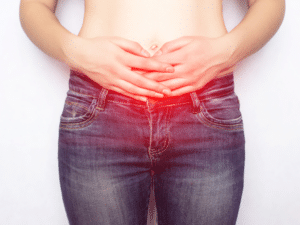Discover what causes abdominal hernias and the common symptoms. Explore how an abdominal binder can help manage discomfort.
Recently, we have been getting many questions about abdominal binders, also called abdominal trusses or sometimes hernia trusses or belts. There exists some confusion about the different types of available binders, their purpose, when to use or not use them, and how to use them.
Some of the recent FAQs include:
- Do you use an abdominal binder for an inguinal hernia after surgery?
- Will using an abdominal binder for an umbilical hernia help me avoid surgery?
- Does using an abdominal binder for incisional hernia repair help you recover faster?
This article will answer these questions and should clear up some of the confusion about abdominal binders for hernias, explaining what they are, the types of binders available, and when to use them. To understand the purpose of an abdominal hernia binder you will need to know a bit about hernias.
What is a Hernia?
Hernias are a common occurrence that can affect men or women. When weakened, stretched, or torn abdominal muscles experience pressure, they can cause a hernia, allowing abdominal tissue (intestines) to protrude through the opening. In particular, Furthermore, Additionally, these weakened areas commonly become separated.
When one exerts pressure on the abdominal muscles, such as when lifting something heavy, most hernias are visible from the outside and consequently bulge or protrude. There are four common types of hernias.
- Inguinal Hernias
- These occur when part of an intestine or the bladder bulges through the wall of the abdomen or groin (the inguinal canal). They occur mostly in men because their groin area is naturally vulnerable. 96% of inguinal hernias occur in the groin area.
- Incisional Hernias
- This type of hernia occurs when previous surgery has weakened the abdominal muscles along the incision line and intestinal tissue pushes through this weak area and out through the abdominal wall.
- Femoral Hernias
- Most common in women (especially if pregnant or higher weight), femoral hernias happen when a weak spot in the abdominal muscle allows intestinal tissue to protrude into the femoral artery canal located in the upper thigh.
- Umbilical Hernias
- These occurs around the belly button when part of the small intestine pushes through the abdominal wall. They are common in newborns and often affect higher-weight women or after multiple pregnancies.
What is an Abdominal Binder?
Many names, including trusses, girdles, compression garments, and abdominal belts, refer to abdominal binders. Depending upon purpose, where it is worn, or geographic location, the name may differ. Moreover, for example, compared to girdles, compression garments more tightly encircle the area. Consequently, abdominal belts are usually used to provide additional support.
The efficacy of an abdominal binder after hernia surgery was much debated until recent years when a randomized trial that ran from May 2019 through December 2020, tested the effectiveness of wearing an abdominal binder after hernia repair surgery.
Participants wore the binders for 14 days after hernia surgery and the study concluded that the patients who wore the binders experienced less post-operative pain and swelling than the control group.
Can Using An Abdominal Binder Help Cure A Hernia?
The short answer is no, an abdominal binder does not fix a hernia. It is important to understand when and how you should wear an abdominal binder. Two types of circumstances would prompt the use of an abdominal binder that is related to hernias.
- 1. Abdominal binder helps contain a hernia and prevent further damage until surgery can be performed hernia truss can be used temporarily if a surgical repair is not accessible right away. It should be noted that the truss isn‘t an alternative to surgery, just a short–term measure.
- 2. Abdominal binder promotes proper healing after hernia repair surgery using an abdominal binder after an incisional hernia repair or another type of hernia repair will help control pain during recovery. The new repair is protected from pressure while sufficient time is given for the area to heal.
Why Do They Use an Abdominal Binder After Hernia Surgery?
By using an abdominal hernia belt, one can help reduce swelling, ease pain, and protect their hernia from sudden movements or pressure caused by activities such as coughing or sneezing. Furthermore, this belt will also aid in providing support to the hernia repair area, thereby facilitating quicker recovery. Additionally, it will also act as a reminder to the individual to take caution and avoid lifting heavy objects or engaging in strenuous activities.
The surgeon will provide instructions about when, how, and how tightly to wear the binder. Additionally, it should fit securely, yet still ensure the area receives adequate circulation. Depending on the extent of your surgery, you may need to wear the abdominal hernia binder for several weeks or up to a few months.
Choosing an abdominal binder after a hernia surgery is easy. Ask your surgeon what type of support you need for the best results. You can obtain three basic garments for use after hernia surgery.
Hernia Underwear
Provides comfort and compression, usually used for groin hernias.
Hernia Trusses
Hernia Binders
Can an Abdominal Binder or Truss Make a Hernia Worse?
Only under a doctor‘s supervision should a hernia truss be worn to help protect and alleviate pain before hernia surgery. Moreover, you should not use a truss indefinitely instead of surgery; otherwise, complications may arise and become serious.
Abdominal binders should only be used after hernia repair, during recovery,y and with a surgeon‘s instructions to avoid serious complications.
Before wearing a hernia truss, make sure to push all herniated tissue back in through the abdominal opening; otherwise, it could get trapped and pinched by the truss, leading to strangulation of the tissue and damage to the intestine, necessitating emergency medical attention. Consequently, take caution and pay close attention when using a hernia truss. Furthermore, it is always best to have a hernia repaired before putting on the truss. Finally, strictly adhere to the instructions given by a medical professional.
If you are currently experiencing a hernia that requires repair contact IBI Healthcare Institute today. Our team of skilled professionals can alleviate your hernia pain and help you avoid a potential medical emergency.
Our Advanced Hernia Center is located and equipped with state-of-the-art Class C operating theaters. Contact us today to set up a call and get answers to all your hernia questions.









